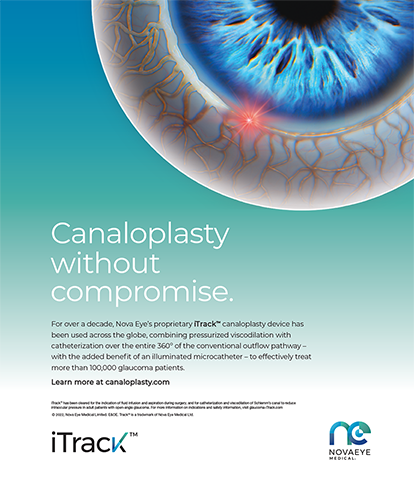


Since its first introduction to patients in 2003 and its US FDA approval in 2016, CXL has become a commonly used treatment to stiffen collagen fibers and prevent the progression of keratoconus and ectasia.1 Utilizing riboflavin and UV-A light, the procedure induces crosslinking between collagen fibers in the cornea. During CXL, riboflavin acts as a photosensitizer, absorbing light and creating reactive oxygen species that facilitate crosslinking and covalent bonds between various proteins.2 Due to its maximum absorption peak at 370 nm, riboflavin allows UV-A light into the anterior stroma of the cornea while also serving as a barrier that protects posterior structures of the eye.3
CXL TECHNIQUES
The standard epithelium-off (epi-off) CXL protocol (widely known as the Dresden protocol) involves removing 7 to 9 mm of the central epithelium, which allows the riboflavin solution to penetrate the cornea. The corneal epithelium can be removed mechanically with a rotating (Amoils) brush or topically with alcohol and a cellulose sponge.4
After removal of the epithelium, riboflavin solution is administered every few minutes for 30 minutes. During this soaking time, corneal thickness is measured periodically to confirm it is greater than 400 µm. If the thickness decreases to less than 400 µm, 0.1% hypoosmolar riboflavin solution may be used and added more frequently.
Once the soaking period is complete, 365-nm UV-A light is delivered for 30 minutes to achieve a total energy dose of 5.4 J/cm2. Riboflavin solution is applied every few minutes during light delivery.5,6
What Is Thick Enough?
A relative contraindication to CXL is an inability to thicken the cornea to at least 400 µm, the minimum depth thought to protect the underlying endothelium. Thus, as mentioned earlier, topical hypoosmolar riboflavin solution may be added to induce thickening of the stroma (up to twice the actual thickness) through the hydrophilic nature of proteins in the stroma. This technique has been successful in patients with corneas that were 320 µm thick after removal of the epithelium.7 Other techniques utilizing modified energy levels based on intraoperative pachymetry have also been reported to crosslink corneas thinner than 400 µm.8
Alternate CXL Methods in Development
The goal with the epithelium-on (epi-on) CXL procedure—a modification to the standard epi-off CXL method—is to decrease patients’ postoperative discomfort, reduce their risk of infection, and expedite their recovery by keeping the epithelium intact before riboflavin administration. Some studies showed inferior results with epi-on CXL compared to the standard epi-off technique due to less effective riboflavin penetration into the stroma.6,9 Current clinical studies are evaluating the safety and efficacy of the epi-on procedure. This method may also reduce the risk of infection and stromal haze.
CXL COMBINED WITH PROCEDURES THAT ALTER THE SHAPE OF THE CORNEA
CXL followed by personalized fitting of hard contact lenses, particularly scleral contact lenses, is our preferred method of vision correction for patients with keratoconus. Scleral contact lenses offer excellent customizable vision while protecting and lubricating the ocular surface.
For patients who are unable to insert or tolerate hard contact lenses and would otherwise need a corneal transplant to improve their BCVA and UCVA, an alternative approach may be to combine CXL with a procedure that reduces astigmatism. Options include PRK, phototherapeutic keratectomy, and corneal stromal tissue addition procedures (eg, corneal tissue addition keratoplasty, corneal allogenic intrastromal ring segments, and automated lamellar keratoplasty-regional segments).
PRK
If considering PRK, we usually wait a minimum of 6 to 12 months after CXL before offering it to patients. The delay allows patients to trial scleral lenses and their corneas to heal and stabilize. Haze appears to be more common in this group of patients, and waiting between surgical procedures may reduce these individuals’ tendency to develop corneal scars after PRK or phototherapeutic keratectomy.
When performing PRK after CXL, we shrink the optical zone to reduce the depth of treatment. Moreover, because there is an increased risk of ectasia, we try to limit tissue removal to less than 40 to 60 µm. Patients typically do not achieve 20/20 UCVA, but the reduction of up to 4.00 to 6.00 D of astigmatism or myopia often decreases their anisometropia.
Stromal Tissue Addition Procedure
In patients with severe keratoconus who cannot tolerate hard contact lenses and would benefit from a significant corneal shape change to decrease their dependence on glasses, a stromal tissue addition procedure combined with CXL can improve the shape of their corneas and reduce disease progression over time.10 The combination of procedures often improves their UCVA and BCVA while allowing them to be fit for scleral contact lenses. When describing this surgical strategy, we use the term anterior lamellar keratoplasty regional segment to aid patient comprehension.
A femtosecond laser is used to create channels in the cornea in preparation for the placement of corneal stromal regional segments to induce flattening of the steep areas. The segments function similarly to a girdle for the cornea. Greenstein et al reported 8.44 D of flattening in the mean keratometry reading with the stromal inlay procedure, a change in patients’ uncorrected distance visual acuity from 1.21 (20/327) to 0.61 (20/82) at 6 months, and an improvement in their corrected distance visual acuity from 0.62 (20/82) to 0.34 (20/43).11 Our initial results with CXL performed on the same day as anterior lamellar keratoplasty regional segment placement have been similar.
THE TRANSFORMATIVE POTENTIAL OF CXL
CXL is a highly effective corneal procedure, particularly when it is performed on young patients and those with the early stages of keratoconus. CXL can stabilize a young patient’s cornea and decrease their risk of future visual impairment or their need for corneal transplantation. Combining CXL with corneal shape-changing procedures can improve a keratoconus patient’s vision while allowing them to be fit for scleral contact lenses. A personalized approach that balances each person’s corneal shape with their desired level of spectacle independence is key to helping patients achieve their vision goals.
1. Spoerl E, Wollensak G, Seiler T. Increased resistance of crosslinked cornea against enzymatic digestion. Curr Eye Res. 2004;29(1):35-40.
2. Meek KM, Hayes S. Corneal cross-linking–a review. Ophthalmic Physiol Opt. 2013;33(2):78-93.
3. Alhayek A, Lu PR. Corneal collagen crosslinking in keratoconus and other eye disease. Int J Ophthalmol. 2015;8(2):407-418.
4. Gaster RN, Ben Margines J, Gaster DN, Li X, Rabinowitz YS. Comparison of the effect of epithelial removal by transepithelial phototherapeutic keratectomy or manual debridement on cross-linking procedures for progressive keratoconus. J Refract Surg. 2016;32(10):699-704.
5. Randleman JB, Khandelwal SS, Hafezi F. Corneal cross-linking. Surv Ophthalmol. 2015;60(6):509-523.
6. Belin MW, Lim L, Rajpal RK, Hafezi F, Gomes JAP, Cochener B. Corneal cross-linking: current USA status: report from the Cornea Society [published correction appears in Cornea. 2019;38(10):e49. doi: 10.1097/ICO.0000000000001901]. Cornea. 2018;37(10):1218-1225.
7. Hafezi F, Mrochen M, Iseli HP, Seiler T. Collagen crosslinking with ultraviolet-A and hypoosmolar riboflavin solution in thin corneas. J Cataract Refract Surg. 2009;35(4):621-624.
8. Hafezi F, Kling S, Gilardoni F, et al. Individualized corneal cross-linking with riboflavin and UV-A in ultrathin corneas: the sub400 protocol. Am J Ophthalmol. 2021;224:133-142.
9. Henriquez MA, Hernandez-Sahagun G, Camargo J, Izquierdo L Jr. Accelerated epi-on versus standard epi-off corneal collagen cross-linking for progressive keratoconus in pediatric patients: five years of follow-up. Cornea. 2020;39(12):1493-1498.
10. Jacob S, Patel SR, Agarwal A, Ramalingam A, Saijimol AI, Raj JM. Corneal allogenic intrastromal ring segments (CAIRS) combined with corneal cross-linking for keratoconus. J Refract Surg. 2018;34(5):296-303.
11. Greenstein SA, Yu AS, Gelles JD, Eshraghi H, Hersh PS. Corneal tissue addition keratoplasty: new intrastromal inlay procedure for keratoconus using femtosecond laser-shaped preserved corneal tissue. J Cataract Refract Surg. 2023;49(7):740-746.




